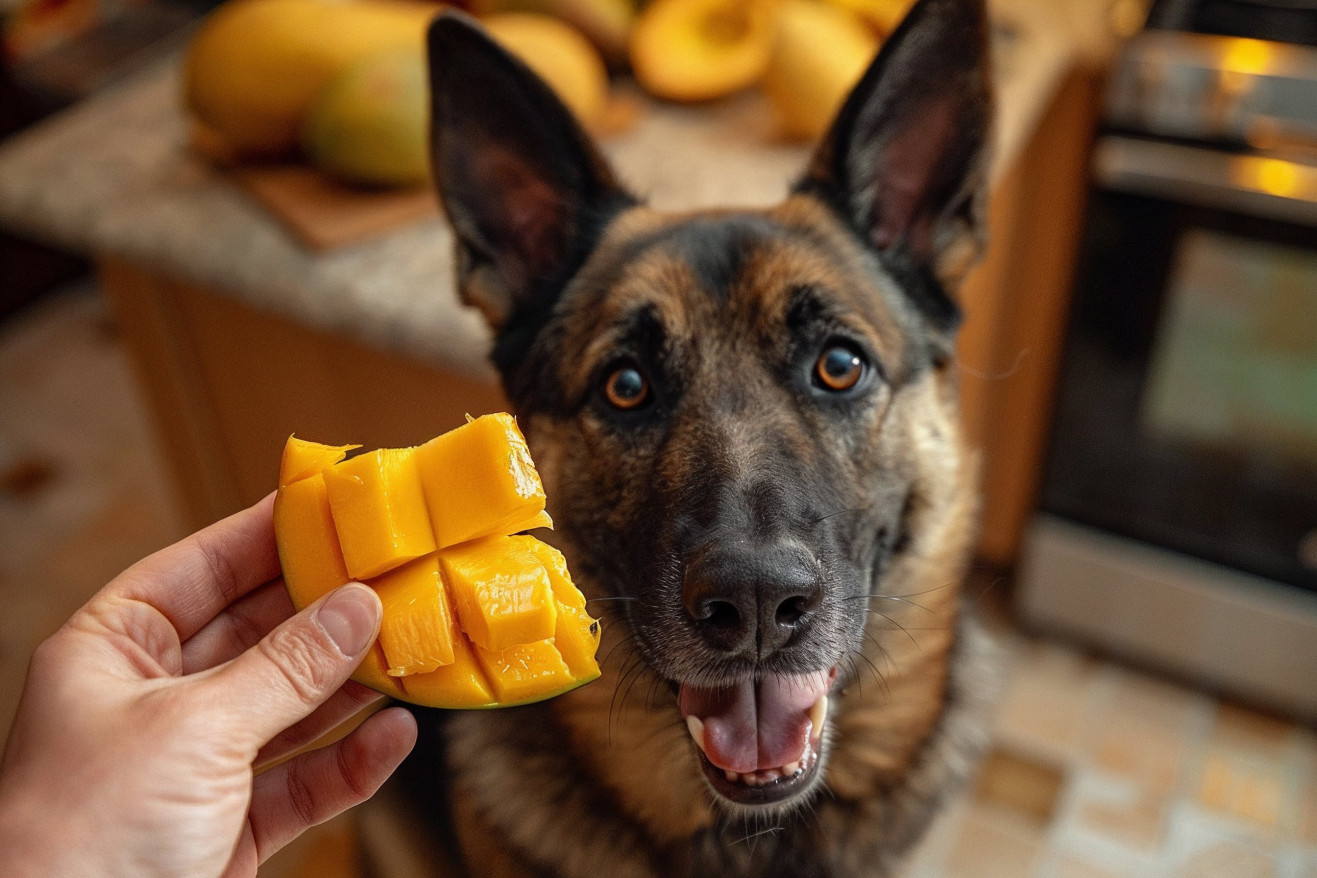Can Dogs Eat Mangos? A Healthy Snack for Your Pup
23 February 2024 • Updated 21 February 2024

Mangoes, a delicious tropical fruit, are a common source of confusion for dog owners wondering if they are safe for their pets. And while mangos are safe for dogs to eat, there are some important things to keep in mind. First, you need to remove the skin and pit, both of which can be toxic, and only give your dog the fruit.
Mangoes are packed with vitamins and fiber, which makes them a nutritious snack, but they are also high in sugar, so they should be fed in moderation.
This article will use expert advice and nutritional information to provide a complete overview of the potential benefits and drawbacks of mangos as part of a dog’s diet. It will also discuss how the sugar in mangos and other fruits can impact a dog’s digestive system and health and whether a dog’s allergies or other health issues could impact their ability to eat this tropical fruit as an occasional treat.
Can dogs eat mangos?
Mango Magic: Breaking Down the Nutritional Value of Mango for Dogs
Mangoes aren’t just a juicy tropical fruit; they are also packed with nutrients that can benefit your dog if they are consumed in the right way. According to Pawlicy Advisor, mangoes are a great source of important vitamins like A, C, B6, and E, which are important for everything from vision to the immune system.
These vitamins are essential for keeping your dog’s eyesight sharp, their coat healthy, and their organs functioning properly.
The dietary fiber in mangoes can also help with your dog’s digestion, which can help prevent issues like diarrhea and constipation, according to Dogs Naturally magazine. Plus, the antioxidants in mangoes can help boost your dog’s immune system and even help protect them from certain illnesses, according to a VCA Hospitals article shared by Pawlicy Advisor.
That said, it’s important to remember that mangoes are high in natural sugars, so they should be fed in moderation to prevent obesity and diabetes, according to USA TODAY.
In general, a quarter cup of fresh mango once or twice a week is a good rule of thumb, although the exact amount will depend on your dog’s size and individual health.
As always, it’s best to talk to your vet for personalized dietary recommendations to make sure that this tropical fruit is a healthy addition to your dog’s diet and not something that will lead to overindulgence.
Mango Munching: A Cautionary Guide for Dog Owners
When it comes to dogs and mangos, owners should be mindful not only of the fruit’s sweet and juicy flesh but also of the potential hazards. The pit is perhaps the most well-known danger, as it can lead to choking and intestinal blockages if a dog swallows it.
In addition, the pit contains trace amounts of cyanide, according to PetMD. Before feeding your dog mango, make sure to remove the skin, which contains urushiol, an irritant found in poison ivy that can lead to vomiting and skin irritation.
While it’s uncommon, some dogs may be allergic to mangos. To be safe, feed your dog small amounts at first and keep an eye out for any signs of distress or allergic reactions.
Dogs that have diabetes or who are trying to lose or maintain their weight should be fed mangos in moderation due to the fruit’s high sugar content, according to the American Kennel Club.
To play it safe, introduce mangos into your dog’s diet slowly, monitor them for signs of an upset stomach or changes in their eating habits, and contact your veterinarian right away if you notice anything concerning.
Digestive Health and Mango Consumption
When feeding your dog fruits like mangos, it’s important to have a good understanding of the canine digestive system. According to Whole Dog Journal, the digestive system is made up of organs like the stomach and intestines, which work together to break down and absorb the nutrients in food.
While dogs have very few digestive enzymes in their saliva, the stomach and intestines are well-equipped to handle a wide range of foods, including the soft, fibrous flesh of mangos.
Rogue Pet Science explains that the fiber in mangos is important for maintaining a healthy digestive system, helping with bowel regularity and preventing constipation.
That said, the high sugar content in mangos can cause digestive upset if it’s consumed in large amounts. To help prevent this, it’s best to remove the skin and pit of the mango and cut the flesh into small pieces to make it easier for dogs to digest and reduce the likelihood of digestive upset.
It’s important to keep in mind that when you’re feeding your dog mangos and other fruits, you should be striving for a balanced diet. As the American Kennel Club points out, while fruits can be a good source of vitamins and antioxidants, they should be fed in moderation as part of a well-balanced diet.
Making sure your dog gets a good mix of nutrients will help ensure that their digestive system and overall health are in good shape, which will make it safe and healthy to add treats like mangos to their diet.
Sweet Caution: How to Control Sugar in Your Dog’s Diet
While sugar isn’t toxic by nature, it can have negative impacts on your dog’s health. For example, mangos are full of nutrients, but the natural sugars in them can lead to obesity, tooth decay, and even diabetes if consumed in excess, according to Trupanion. Not only do these issues lower your dog’s quality of life, but they can also lead to other health problems down the line.
If you’re worried about the sugar content in mangos, Pettsie suggests feeding your dog fruits that are lower in sugar, like blueberries and apples, which can still satisfy their sweet tooth without the high sugar content. This can help you make sure your dog’s diet is well-rounded while still keeping their sugar intake in check.
As with anything, the key to feeding your dog treats is moderation. Holiday Barn Pet Resorts notes that feeding your dog treats that are free of sugar alcohols and artificial sweeteners can help control your dog’s sugar intake. Make sure that your dog’s diet is supplemented with fresh water and plenty of exercise to keep them healthy.
Work with your vet to evaluate and potentially change your dog’s diet, especially when it comes to sugar. They can help you come up with a plan that’s tailored to your dog’s needs and make sure that treats like mangos can continue to be a safe and fun part of their diet.
Mango Allergies in Dogs: What Pet Owners Should Know
Although it is not common, dogs can have an allergic reaction to mangos. The American Academy of Allergy, Asthma & Immunology explains that cross-reactivity between mangos and other things like cashews could be an issue if your dog already has allergies. Symptoms of a mango allergy in dogs include itching, swelling, digestive issues, and trouble breathing. This is consistent with the symptoms of mango allergies in humans, according to Medicina.
Your dog’s reaction to mangos may depend on their individual health history, including any allergies to specific proteins or plants. According to Allergy, Asthma & Clinical Immunology, profilins in mango can cause cross-reactions with other fruits and vegetables in humans, which may mean that dogs are also susceptible to cross-reactions.
Dog owners should watch their pets carefully after giving them mango for the first time. If they notice any signs of an allergic reaction, they should seek veterinary care right away. Since every dog is different, a vet can provide personalized guidance to make sure that your dog can eat mango safely. It’s important to note that personalized professional assessments are important when you’re introducing new foods to your dog.
So, Can Dogs Eat Mangos?
As we’ve learned, mangos can be a healthy and tasty snack for your dog, packed with vitamins and fiber that can help support their well-being. However, as with anything, it’s important to use mangos in moderation. It’s also important to make sure that you’re cutting and serving mangos in a way that’s safe for your dog, and that you’re only giving them an amount that’s appropriate based on their size and health status.
Every dog is different, and what works for one dog may not work for another. That’s why it’s important to consider your dog’s specific dietary needs and any health conditions they may have before you start feeding them mangos. If you’re not sure what’s best for your dog, your veterinarian can help you come up with a plan that’s tailored to their unique needs.
When used responsibly, mangos can be a fun addition to your dog’s diet that can also support their health. Just remember that being a good pet parent means more than giving your dog love and attention. It also means making sure that you’re meeting their nutritional needs. Regular check-ins with your vet will help ensure that your dog’s tail keeps wagging, whether or not they ever get to taste a mango.


